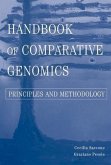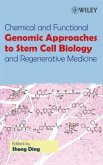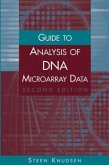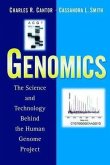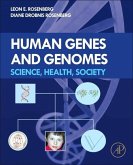Richard J. Reece
Analysis of Genes and Genomes
Schade – dieser Artikel ist leider ausverkauft. Sobald wir wissen, ob und wann der Artikel wieder verfügbar ist, informieren wir Sie an dieser Stelle.
Richard J. Reece
Analysis of Genes and Genomes
- Gebundenes Buch
- Merkliste
- Auf die Merkliste
- Bewerten Bewerten
- Teilen
- Produkt teilen
- Produkterinnerung
- Produkterinnerung
* All aspects of genetic engineering in the post-genomic era are covered, beginning with the basics of DNA structure and DNA metabolism. * Strong emphasis is placed on the latest, post genomic technologies including DNA macro and microarrays, genome-wide two hybrid analysis, proteomics and bioinformatics.
Andere Kunden interessierten sich auch für
![Handbook of Comparative Genomics Handbook of Comparative Genomics]() Cecilia SacconeHandbook of Comparative Genomics210,99 €
Cecilia SacconeHandbook of Comparative Genomics210,99 €![Chemical and Functional Genomic Approaches to Stem Cell Biology and Regenerative Medicine Chemical and Functional Genomic Approaches to Stem Cell Biology and Regenerative Medicine]() Chemical and Functional Genomic Approaches to Stem Cell Biology and Regenerative Medicine125,99 €
Chemical and Functional Genomic Approaches to Stem Cell Biology and Regenerative Medicine125,99 €![Guide to Analysis of DNA Microarray Data Guide to Analysis of DNA Microarray Data]() Steen KnudsenGuide to Analysis of DNA Microarray Data101,99 €
Steen KnudsenGuide to Analysis of DNA Microarray Data101,99 €![Genomics Genomics]() Charles R. CantorGenomics252,99 €
Charles R. CantorGenomics252,99 €![Human Genes and Genomes Human Genes and Genomes]() Leon RosenbergHuman Genes and Genomes97,99 €
Leon RosenbergHuman Genes and Genomes97,99 €![Genome, Transcriptome and Proteome Analysis Genome, Transcriptome and Proteome Analysis]() Alain BernotGenome, Transcriptome and Proteome Analysis95,99 €
Alain BernotGenome, Transcriptome and Proteome Analysis95,99 €![Genom und Glaube Genom und Glaube]() Hausen, Harald, zurGenom und Glaube44,99 €
Hausen, Harald, zurGenom und Glaube44,99 €-
-
-
* All aspects of genetic engineering in the post-genomic era are covered, beginning with the basics of DNA structure and DNA metabolism. * Strong emphasis is placed on the latest, post genomic technologies including DNA macro and microarrays, genome-wide two hybrid analysis, proteomics and bioinformatics.
Produktdetails
- Produktdetails
- Verlag: John Wiley and Sons Ltd
- Seitenzahl: 520
- Erscheinungstermin: 15. Juni 2023
- Englisch
- Abmessung: 244mm x 170mm
- ISBN-13: 9780470777824
- ISBN-10: 0470777826
- Artikelnr.: 35456835
- Herstellerkennzeichnung
- Libri GmbH
- Europaallee 1
- 36244 Bad Hersfeld
- gpsr@libri.de
- Verlag: John Wiley and Sons Ltd
- Seitenzahl: 520
- Erscheinungstermin: 15. Juni 2023
- Englisch
- Abmessung: 244mm x 170mm
- ISBN-13: 9780470777824
- ISBN-10: 0470777826
- Artikelnr.: 35456835
- Herstellerkennzeichnung
- Libri GmbH
- Europaallee 1
- 36244 Bad Hersfeld
- gpsr@libri.de
Preface xiii Acknowledgements xv Abbreviations and acronyms xvii 1 DNA: Structure and function 1 1.1 Nucleic acid is the material of heredity 2 1.2 Structure of nucleic acids 7 1.3 The double helix 11 1.3.1 The antiparallel helix 12 1.3.2 Base pairs and stacking 14 1.3.3 Gaining access to information with the double helix without breaking it apart 16 1.3.4 Hydrogen bonding 17 1.4 Reversible denaturing of DNA 18 1.5 Structure of DNA in the cell 21 1.6 The eukaryotic nucleosome 24 1.7 The replication of DNA 28 1.8 DNA polymerases 31 1.9 The replication process 33 1.10 Recombination 37 1.11 Genes and genomes 39 1.12 Genes within a genome 40 1.13 Transcription 43 1.13.1 Transcription in prokaryotes 43 1.13.2 Transcription in eukaryotes 46 1.14 RNA processing 54 1.14.1 RNA splicing 55 1.14.2 Alternative splicing 58 1.15 Translation 59 2 Basic techniques in gene analysis 65 2.1 Restriction enzymes 66 2.1.1 Types of restriction-modification system 70 2.1.2 Other modification systems 72 2.1.3 How do type II restriction enzymes work? 74 2.2 Joining DNA molecules 76 2.3 The basics of cloning 78 2.4 Bacterial transformation 84 2.4.1 Chemical transformation 86 2.4.2 Electroporation 87 2.4.3 Gene gun 88 2.5 Gel electrophoresis 88 2.5.1 Polyacrylamide gels 89 2.5.2 Agarose gels 89 2.5.3 Pulsed-field gel electrophoresis 95 2.6 Nucleic acid blotting 98 2.6.1 Southern blotting 100 2.6.2 The compass points of blotting 102 2.7 DNA purification 103 3 Vectors 109 3.1 Plasmids 112 3.1.1 pBR 322 116 3.1.2 pUC plasmids 119 3.2 Selectable markers 122 3.3
vectors 126 3.4 Cosmid vectors 135 3.5 M13 vectors 137 3.6 Phagemids 140 3.7 Artificial chromosomes 142 3.7.1 YACs 143 3.7.2 PACs 146 3.7.3 BACs 148 3.7.4 HACs 149 4 Polymerase chain reaction 153 4.1 PCR reaction conditions 159 4.2 Thermostable DNA polymerases 162 4.3 Template DNA 164 4.4 Oligonucleotide primers 165 4.4.1 Synthesis of oligonucleotide primers 167 4.5 Primer mismatches 169 4.6 PCR in the diagnosis of genetic disease 173 4.7 Cloning PCR products 175 4.8 RT-PCR 177 4.9 Real-time PCR 179 4.10 Applications of PCR 181 5 Cloning a gene 183 5.1 Genomic libraries 185 5.2 cDNA libraries 191 5.3 Directional cDNA cloning 196 5.4 PCR based libraries 199 5.5 Subtraction libraries 200 5.6 Library construction in the post-genome era 204 6 Gene identification 205 6.1 Screening by nucleic acid hybridization 206 6.2 Immunoscreening 211 6.3 Screening by function 216 6.4 Screening by interaction 217 6.5 Phage display 218 6.6 Two-hybrid screening 218 6.6.1 Problems, and some solutions, with two-hybrid screening 225 6.7 Other interaction screens - variations on a theme 228 6.7.1 One hybrid 229 6.7.2 Three hybrid 229 6.7.3 Reverse two hybrid 229 7 Creating mutations 231 7.1 Creating specific DNA changes using primer extension mutagenesis 233 7.2 Strand selection methods 237 7.2.1 Phosphorothioate strand selection 237 7.2.2 dut
ung
(or Kunkel) strand selection 238 7.3 Cassette mutagenesis 240 7.4 PCR based mutagenesis 241 7.5 QuikChange ® mutagenesis 248 7.6 Creating random mutations in specific genes 250 7.7 Protein engineering 254 8 Protein production and purification 257 8.1 Expression in E. coli 258 8.1.1 The lac promoter 259 8.1.2 The tac promoter 259 8.1.3 The
P L promoter 260 8.1.4 The T7 expression system 261 8.2 Expression in yeast 265 8.2.1 Saccharomyces cerevisiae 265 8.2.1.1 The GAL system 266 8.2.1.2 The CUP1 system 268 8.2.2 Pichia pastoris 268 8.2.3 Schizosaccharomyces pombe 269 8.3 Expression in insect cells 269 8.4 Expression in higher-Eukaryotic cells 272 8.4.1 Tet-on/Tet-off system 272 8.5 Protein purification 275 8.5.1 The His-tag 276 8.5.2 The GST-tag 279 8.5.3 The MBP-tag 282 8.5.4 Impact 282 8.5.5 TAP-tagging 286 9 Genome sequencing projects 287 9.1 Genomic mapping 289 9.2 Genetic mapping 290 9.3 Physical mapping 293 9.4 Nucleotide sequencing 295 9.4.1 Manual DNA sequencing 296 9.4.2 Automated DNA sequencing 300 9.5 Genome sequencing 303 9.6 The human genome project 305 9.7 Finding genes 307 9.8 Gene assignment 309 9.9 Bioinformatics 311 10 Post-genome analysis 313 10.1 Global changes in gene expression 314 10.1.1 Differential display 315 10.1.2 Microarrays 317 10.1.3 ChIPs with everything 324 10.2 Protein function on a genome-wide scale 327 10.3 Knock-out analysis 327 10.4 Antisense and RNA interference (RNAi) 329 10.5 Genome-wide two-hybrid screens 333 10.6 Protein detection arrays 335 10.7 Structural genomics 335 11 Engineering plants 341 11.1 Cloning in plants 341 11.1.1 Agrobacterium tumefaciens 342 11.1.2 Direct nuclear transformation 347 11.1.3 Viral vectors 348 11.1.4 Chloroplast transformation 350 11.2 Commercial exploitation of plant transgenics 354 11.2.1 Delayed ripening 354 11.2.2 Insecticidal resistance 355 11.2.3 Herbicidal resistance 356 11.2.4 Viral resistance 357 11.2.5 Fungal resistance 358 11.2.6 Terminator technology 358 11.3 Ethics of genetically engineered crops 360 12 Engineering animal cells 361 12.1 Cell culture 361 12.2 Transfection of animal cells 362 12.2.1 Chemical transfection 363 12.2.2 Electroporation 364 12.2.3 Liposome-mediated transfection 364 12.2.4 Peptides 366 12.2.5 Direct DNA transfer 366 12.3 Viruses as vectors 367 12.3.1 SV 40 367 12.3.2 Adenovirus 369 12.3.3 Adeno-associated virus (AAV) 371 12.3.4 Retrovirus 372 12.4 Selectable markers and gene amplification in animal cells 375 12.5 Expressing genes in animal cells 378 13 Engineering animals 379 13.1 Pronuclear injection 381 13.2 Embryonic stem cells 384 13.3 Nuclear transfer 390 13.4 Gene therapy 396 13.5 Examples and potential of gene therapy 398 Glossary 401 Proteins 409 A. 1 409 A1. 2 410 A1. 3 411 Nobel prize winners 413 References 417 Index 459
vectors 126 3.4 Cosmid vectors 135 3.5 M13 vectors 137 3.6 Phagemids 140 3.7 Artificial chromosomes 142 3.7.1 YACs 143 3.7.2 PACs 146 3.7.3 BACs 148 3.7.4 HACs 149 4 Polymerase chain reaction 153 4.1 PCR reaction conditions 159 4.2 Thermostable DNA polymerases 162 4.3 Template DNA 164 4.4 Oligonucleotide primers 165 4.4.1 Synthesis of oligonucleotide primers 167 4.5 Primer mismatches 169 4.6 PCR in the diagnosis of genetic disease 173 4.7 Cloning PCR products 175 4.8 RT-PCR 177 4.9 Real-time PCR 179 4.10 Applications of PCR 181 5 Cloning a gene 183 5.1 Genomic libraries 185 5.2 cDNA libraries 191 5.3 Directional cDNA cloning 196 5.4 PCR based libraries 199 5.5 Subtraction libraries 200 5.6 Library construction in the post-genome era 204 6 Gene identification 205 6.1 Screening by nucleic acid hybridization 206 6.2 Immunoscreening 211 6.3 Screening by function 216 6.4 Screening by interaction 217 6.5 Phage display 218 6.6 Two-hybrid screening 218 6.6.1 Problems, and some solutions, with two-hybrid screening 225 6.7 Other interaction screens - variations on a theme 228 6.7.1 One hybrid 229 6.7.2 Three hybrid 229 6.7.3 Reverse two hybrid 229 7 Creating mutations 231 7.1 Creating specific DNA changes using primer extension mutagenesis 233 7.2 Strand selection methods 237 7.2.1 Phosphorothioate strand selection 237 7.2.2 dut
ung
(or Kunkel) strand selection 238 7.3 Cassette mutagenesis 240 7.4 PCR based mutagenesis 241 7.5 QuikChange ® mutagenesis 248 7.6 Creating random mutations in specific genes 250 7.7 Protein engineering 254 8 Protein production and purification 257 8.1 Expression in E. coli 258 8.1.1 The lac promoter 259 8.1.2 The tac promoter 259 8.1.3 The
P L promoter 260 8.1.4 The T7 expression system 261 8.2 Expression in yeast 265 8.2.1 Saccharomyces cerevisiae 265 8.2.1.1 The GAL system 266 8.2.1.2 The CUP1 system 268 8.2.2 Pichia pastoris 268 8.2.3 Schizosaccharomyces pombe 269 8.3 Expression in insect cells 269 8.4 Expression in higher-Eukaryotic cells 272 8.4.1 Tet-on/Tet-off system 272 8.5 Protein purification 275 8.5.1 The His-tag 276 8.5.2 The GST-tag 279 8.5.3 The MBP-tag 282 8.5.4 Impact 282 8.5.5 TAP-tagging 286 9 Genome sequencing projects 287 9.1 Genomic mapping 289 9.2 Genetic mapping 290 9.3 Physical mapping 293 9.4 Nucleotide sequencing 295 9.4.1 Manual DNA sequencing 296 9.4.2 Automated DNA sequencing 300 9.5 Genome sequencing 303 9.6 The human genome project 305 9.7 Finding genes 307 9.8 Gene assignment 309 9.9 Bioinformatics 311 10 Post-genome analysis 313 10.1 Global changes in gene expression 314 10.1.1 Differential display 315 10.1.2 Microarrays 317 10.1.3 ChIPs with everything 324 10.2 Protein function on a genome-wide scale 327 10.3 Knock-out analysis 327 10.4 Antisense and RNA interference (RNAi) 329 10.5 Genome-wide two-hybrid screens 333 10.6 Protein detection arrays 335 10.7 Structural genomics 335 11 Engineering plants 341 11.1 Cloning in plants 341 11.1.1 Agrobacterium tumefaciens 342 11.1.2 Direct nuclear transformation 347 11.1.3 Viral vectors 348 11.1.4 Chloroplast transformation 350 11.2 Commercial exploitation of plant transgenics 354 11.2.1 Delayed ripening 354 11.2.2 Insecticidal resistance 355 11.2.3 Herbicidal resistance 356 11.2.4 Viral resistance 357 11.2.5 Fungal resistance 358 11.2.6 Terminator technology 358 11.3 Ethics of genetically engineered crops 360 12 Engineering animal cells 361 12.1 Cell culture 361 12.2 Transfection of animal cells 362 12.2.1 Chemical transfection 363 12.2.2 Electroporation 364 12.2.3 Liposome-mediated transfection 364 12.2.4 Peptides 366 12.2.5 Direct DNA transfer 366 12.3 Viruses as vectors 367 12.3.1 SV 40 367 12.3.2 Adenovirus 369 12.3.3 Adeno-associated virus (AAV) 371 12.3.4 Retrovirus 372 12.4 Selectable markers and gene amplification in animal cells 375 12.5 Expressing genes in animal cells 378 13 Engineering animals 379 13.1 Pronuclear injection 381 13.2 Embryonic stem cells 384 13.3 Nuclear transfer 390 13.4 Gene therapy 396 13.5 Examples and potential of gene therapy 398 Glossary 401 Proteins 409 A. 1 409 A1. 2 410 A1. 3 411 Nobel prize winners 413 References 417 Index 459
Preface xiii Acknowledgements xv Abbreviations and acronyms xvii 1 DNA: Structure and function 1 1.1 Nucleic acid is the material of heredity 2 1.2 Structure of nucleic acids 7 1.3 The double helix 11 1.3.1 The antiparallel helix 12 1.3.2 Base pairs and stacking 14 1.3.3 Gaining access to information with the double helix without breaking it apart 16 1.3.4 Hydrogen bonding 17 1.4 Reversible denaturing of DNA 18 1.5 Structure of DNA in the cell 21 1.6 The eukaryotic nucleosome 24 1.7 The replication of DNA 28 1.8 DNA polymerases 31 1.9 The replication process 33 1.10 Recombination 37 1.11 Genes and genomes 39 1.12 Genes within a genome 40 1.13 Transcription 43 1.13.1 Transcription in prokaryotes 43 1.13.2 Transcription in eukaryotes 46 1.14 RNA processing 54 1.14.1 RNA splicing 55 1.14.2 Alternative splicing 58 1.15 Translation 59 2 Basic techniques in gene analysis 65 2.1 Restriction enzymes 66 2.1.1 Types of restriction-modification system 70 2.1.2 Other modification systems 72 2.1.3 How do type II restriction enzymes work? 74 2.2 Joining DNA molecules 76 2.3 The basics of cloning 78 2.4 Bacterial transformation 84 2.4.1 Chemical transformation 86 2.4.2 Electroporation 87 2.4.3 Gene gun 88 2.5 Gel electrophoresis 88 2.5.1 Polyacrylamide gels 89 2.5.2 Agarose gels 89 2.5.3 Pulsed-field gel electrophoresis 95 2.6 Nucleic acid blotting 98 2.6.1 Southern blotting 100 2.6.2 The compass points of blotting 102 2.7 DNA purification 103 3 Vectors 109 3.1 Plasmids 112 3.1.1 pBR 322 116 3.1.2 pUC plasmids 119 3.2 Selectable markers 122 3.3
vectors 126 3.4 Cosmid vectors 135 3.5 M13 vectors 137 3.6 Phagemids 140 3.7 Artificial chromosomes 142 3.7.1 YACs 143 3.7.2 PACs 146 3.7.3 BACs 148 3.7.4 HACs 149 4 Polymerase chain reaction 153 4.1 PCR reaction conditions 159 4.2 Thermostable DNA polymerases 162 4.3 Template DNA 164 4.4 Oligonucleotide primers 165 4.4.1 Synthesis of oligonucleotide primers 167 4.5 Primer mismatches 169 4.6 PCR in the diagnosis of genetic disease 173 4.7 Cloning PCR products 175 4.8 RT-PCR 177 4.9 Real-time PCR 179 4.10 Applications of PCR 181 5 Cloning a gene 183 5.1 Genomic libraries 185 5.2 cDNA libraries 191 5.3 Directional cDNA cloning 196 5.4 PCR based libraries 199 5.5 Subtraction libraries 200 5.6 Library construction in the post-genome era 204 6 Gene identification 205 6.1 Screening by nucleic acid hybridization 206 6.2 Immunoscreening 211 6.3 Screening by function 216 6.4 Screening by interaction 217 6.5 Phage display 218 6.6 Two-hybrid screening 218 6.6.1 Problems, and some solutions, with two-hybrid screening 225 6.7 Other interaction screens - variations on a theme 228 6.7.1 One hybrid 229 6.7.2 Three hybrid 229 6.7.3 Reverse two hybrid 229 7 Creating mutations 231 7.1 Creating specific DNA changes using primer extension mutagenesis 233 7.2 Strand selection methods 237 7.2.1 Phosphorothioate strand selection 237 7.2.2 dut
ung
(or Kunkel) strand selection 238 7.3 Cassette mutagenesis 240 7.4 PCR based mutagenesis 241 7.5 QuikChange ® mutagenesis 248 7.6 Creating random mutations in specific genes 250 7.7 Protein engineering 254 8 Protein production and purification 257 8.1 Expression in E. coli 258 8.1.1 The lac promoter 259 8.1.2 The tac promoter 259 8.1.3 The
P L promoter 260 8.1.4 The T7 expression system 261 8.2 Expression in yeast 265 8.2.1 Saccharomyces cerevisiae 265 8.2.1.1 The GAL system 266 8.2.1.2 The CUP1 system 268 8.2.2 Pichia pastoris 268 8.2.3 Schizosaccharomyces pombe 269 8.3 Expression in insect cells 269 8.4 Expression in higher-Eukaryotic cells 272 8.4.1 Tet-on/Tet-off system 272 8.5 Protein purification 275 8.5.1 The His-tag 276 8.5.2 The GST-tag 279 8.5.3 The MBP-tag 282 8.5.4 Impact 282 8.5.5 TAP-tagging 286 9 Genome sequencing projects 287 9.1 Genomic mapping 289 9.2 Genetic mapping 290 9.3 Physical mapping 293 9.4 Nucleotide sequencing 295 9.4.1 Manual DNA sequencing 296 9.4.2 Automated DNA sequencing 300 9.5 Genome sequencing 303 9.6 The human genome project 305 9.7 Finding genes 307 9.8 Gene assignment 309 9.9 Bioinformatics 311 10 Post-genome analysis 313 10.1 Global changes in gene expression 314 10.1.1 Differential display 315 10.1.2 Microarrays 317 10.1.3 ChIPs with everything 324 10.2 Protein function on a genome-wide scale 327 10.3 Knock-out analysis 327 10.4 Antisense and RNA interference (RNAi) 329 10.5 Genome-wide two-hybrid screens 333 10.6 Protein detection arrays 335 10.7 Structural genomics 335 11 Engineering plants 341 11.1 Cloning in plants 341 11.1.1 Agrobacterium tumefaciens 342 11.1.2 Direct nuclear transformation 347 11.1.3 Viral vectors 348 11.1.4 Chloroplast transformation 350 11.2 Commercial exploitation of plant transgenics 354 11.2.1 Delayed ripening 354 11.2.2 Insecticidal resistance 355 11.2.3 Herbicidal resistance 356 11.2.4 Viral resistance 357 11.2.5 Fungal resistance 358 11.2.6 Terminator technology 358 11.3 Ethics of genetically engineered crops 360 12 Engineering animal cells 361 12.1 Cell culture 361 12.2 Transfection of animal cells 362 12.2.1 Chemical transfection 363 12.2.2 Electroporation 364 12.2.3 Liposome-mediated transfection 364 12.2.4 Peptides 366 12.2.5 Direct DNA transfer 366 12.3 Viruses as vectors 367 12.3.1 SV 40 367 12.3.2 Adenovirus 369 12.3.3 Adeno-associated virus (AAV) 371 12.3.4 Retrovirus 372 12.4 Selectable markers and gene amplification in animal cells 375 12.5 Expressing genes in animal cells 378 13 Engineering animals 379 13.1 Pronuclear injection 381 13.2 Embryonic stem cells 384 13.3 Nuclear transfer 390 13.4 Gene therapy 396 13.5 Examples and potential of gene therapy 398 Glossary 401 Proteins 409 A. 1 409 A1. 2 410 A1. 3 411 Nobel prize winners 413 References 417 Index 459
vectors 126 3.4 Cosmid vectors 135 3.5 M13 vectors 137 3.6 Phagemids 140 3.7 Artificial chromosomes 142 3.7.1 YACs 143 3.7.2 PACs 146 3.7.3 BACs 148 3.7.4 HACs 149 4 Polymerase chain reaction 153 4.1 PCR reaction conditions 159 4.2 Thermostable DNA polymerases 162 4.3 Template DNA 164 4.4 Oligonucleotide primers 165 4.4.1 Synthesis of oligonucleotide primers 167 4.5 Primer mismatches 169 4.6 PCR in the diagnosis of genetic disease 173 4.7 Cloning PCR products 175 4.8 RT-PCR 177 4.9 Real-time PCR 179 4.10 Applications of PCR 181 5 Cloning a gene 183 5.1 Genomic libraries 185 5.2 cDNA libraries 191 5.3 Directional cDNA cloning 196 5.4 PCR based libraries 199 5.5 Subtraction libraries 200 5.6 Library construction in the post-genome era 204 6 Gene identification 205 6.1 Screening by nucleic acid hybridization 206 6.2 Immunoscreening 211 6.3 Screening by function 216 6.4 Screening by interaction 217 6.5 Phage display 218 6.6 Two-hybrid screening 218 6.6.1 Problems, and some solutions, with two-hybrid screening 225 6.7 Other interaction screens - variations on a theme 228 6.7.1 One hybrid 229 6.7.2 Three hybrid 229 6.7.3 Reverse two hybrid 229 7 Creating mutations 231 7.1 Creating specific DNA changes using primer extension mutagenesis 233 7.2 Strand selection methods 237 7.2.1 Phosphorothioate strand selection 237 7.2.2 dut
ung
(or Kunkel) strand selection 238 7.3 Cassette mutagenesis 240 7.4 PCR based mutagenesis 241 7.5 QuikChange ® mutagenesis 248 7.6 Creating random mutations in specific genes 250 7.7 Protein engineering 254 8 Protein production and purification 257 8.1 Expression in E. coli 258 8.1.1 The lac promoter 259 8.1.2 The tac promoter 259 8.1.3 The
P L promoter 260 8.1.4 The T7 expression system 261 8.2 Expression in yeast 265 8.2.1 Saccharomyces cerevisiae 265 8.2.1.1 The GAL system 266 8.2.1.2 The CUP1 system 268 8.2.2 Pichia pastoris 268 8.2.3 Schizosaccharomyces pombe 269 8.3 Expression in insect cells 269 8.4 Expression in higher-Eukaryotic cells 272 8.4.1 Tet-on/Tet-off system 272 8.5 Protein purification 275 8.5.1 The His-tag 276 8.5.2 The GST-tag 279 8.5.3 The MBP-tag 282 8.5.4 Impact 282 8.5.5 TAP-tagging 286 9 Genome sequencing projects 287 9.1 Genomic mapping 289 9.2 Genetic mapping 290 9.3 Physical mapping 293 9.4 Nucleotide sequencing 295 9.4.1 Manual DNA sequencing 296 9.4.2 Automated DNA sequencing 300 9.5 Genome sequencing 303 9.6 The human genome project 305 9.7 Finding genes 307 9.8 Gene assignment 309 9.9 Bioinformatics 311 10 Post-genome analysis 313 10.1 Global changes in gene expression 314 10.1.1 Differential display 315 10.1.2 Microarrays 317 10.1.3 ChIPs with everything 324 10.2 Protein function on a genome-wide scale 327 10.3 Knock-out analysis 327 10.4 Antisense and RNA interference (RNAi) 329 10.5 Genome-wide two-hybrid screens 333 10.6 Protein detection arrays 335 10.7 Structural genomics 335 11 Engineering plants 341 11.1 Cloning in plants 341 11.1.1 Agrobacterium tumefaciens 342 11.1.2 Direct nuclear transformation 347 11.1.3 Viral vectors 348 11.1.4 Chloroplast transformation 350 11.2 Commercial exploitation of plant transgenics 354 11.2.1 Delayed ripening 354 11.2.2 Insecticidal resistance 355 11.2.3 Herbicidal resistance 356 11.2.4 Viral resistance 357 11.2.5 Fungal resistance 358 11.2.6 Terminator technology 358 11.3 Ethics of genetically engineered crops 360 12 Engineering animal cells 361 12.1 Cell culture 361 12.2 Transfection of animal cells 362 12.2.1 Chemical transfection 363 12.2.2 Electroporation 364 12.2.3 Liposome-mediated transfection 364 12.2.4 Peptides 366 12.2.5 Direct DNA transfer 366 12.3 Viruses as vectors 367 12.3.1 SV 40 367 12.3.2 Adenovirus 369 12.3.3 Adeno-associated virus (AAV) 371 12.3.4 Retrovirus 372 12.4 Selectable markers and gene amplification in animal cells 375 12.5 Expressing genes in animal cells 378 13 Engineering animals 379 13.1 Pronuclear injection 381 13.2 Embryonic stem cells 384 13.3 Nuclear transfer 390 13.4 Gene therapy 396 13.5 Examples and potential of gene therapy 398 Glossary 401 Proteins 409 A. 1 409 A1. 2 410 A1. 3 411 Nobel prize winners 413 References 417 Index 459
"It could be an excellent supporting book to go along with a more general text in a course covering molecular biology." (Biochemistry and Molecular Education, July/ August 2004)
"...the list of relevant Nobel laureates at the end will be useful and was a delight..." (Heredity, Vol. 94, 2005)
"...the full range of topics one would wish to see in such a book are covered...I certainly welcome the book..." (Genetical Research, Vol.84, 2004)
" ... invaluable to those looking to better understand the complexities and capabilities of these important new technologies." (Thaiszia Journal of Botany, Vol. 15; 173-185, 2005)
"...the list of relevant Nobel laureates at the end will be useful and was a delight..." (Heredity, Vol. 94, 2005)
"...the full range of topics one would wish to see in such a book are covered...I certainly welcome the book..." (Genetical Research, Vol.84, 2004)
" ... invaluable to those looking to better understand the complexities and capabilities of these important new technologies." (Thaiszia Journal of Botany, Vol. 15; 173-185, 2005)


